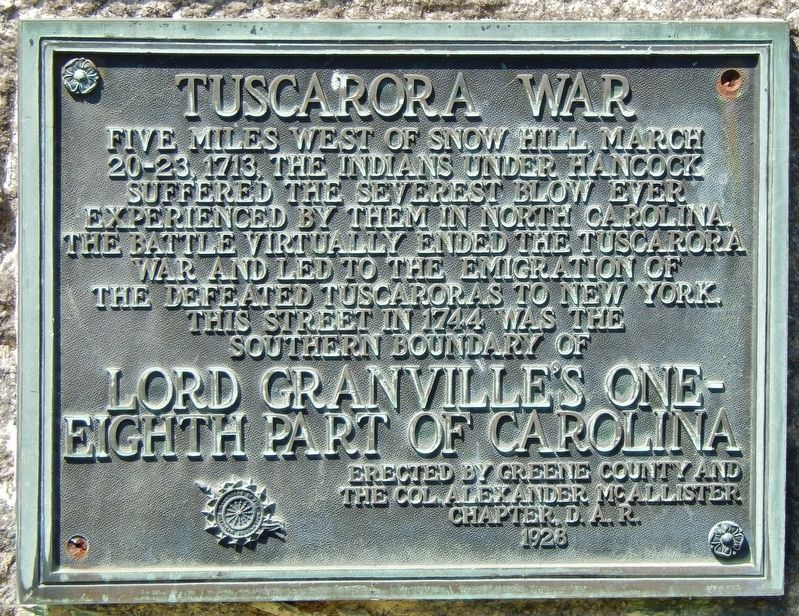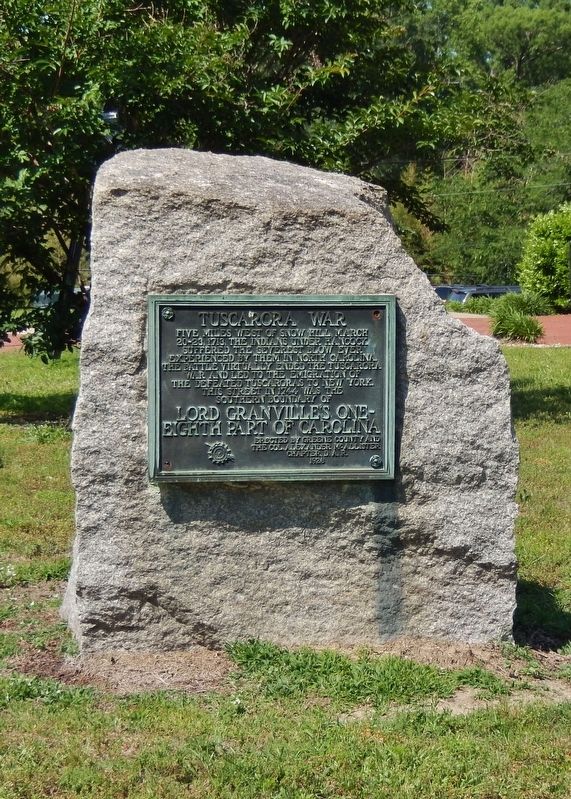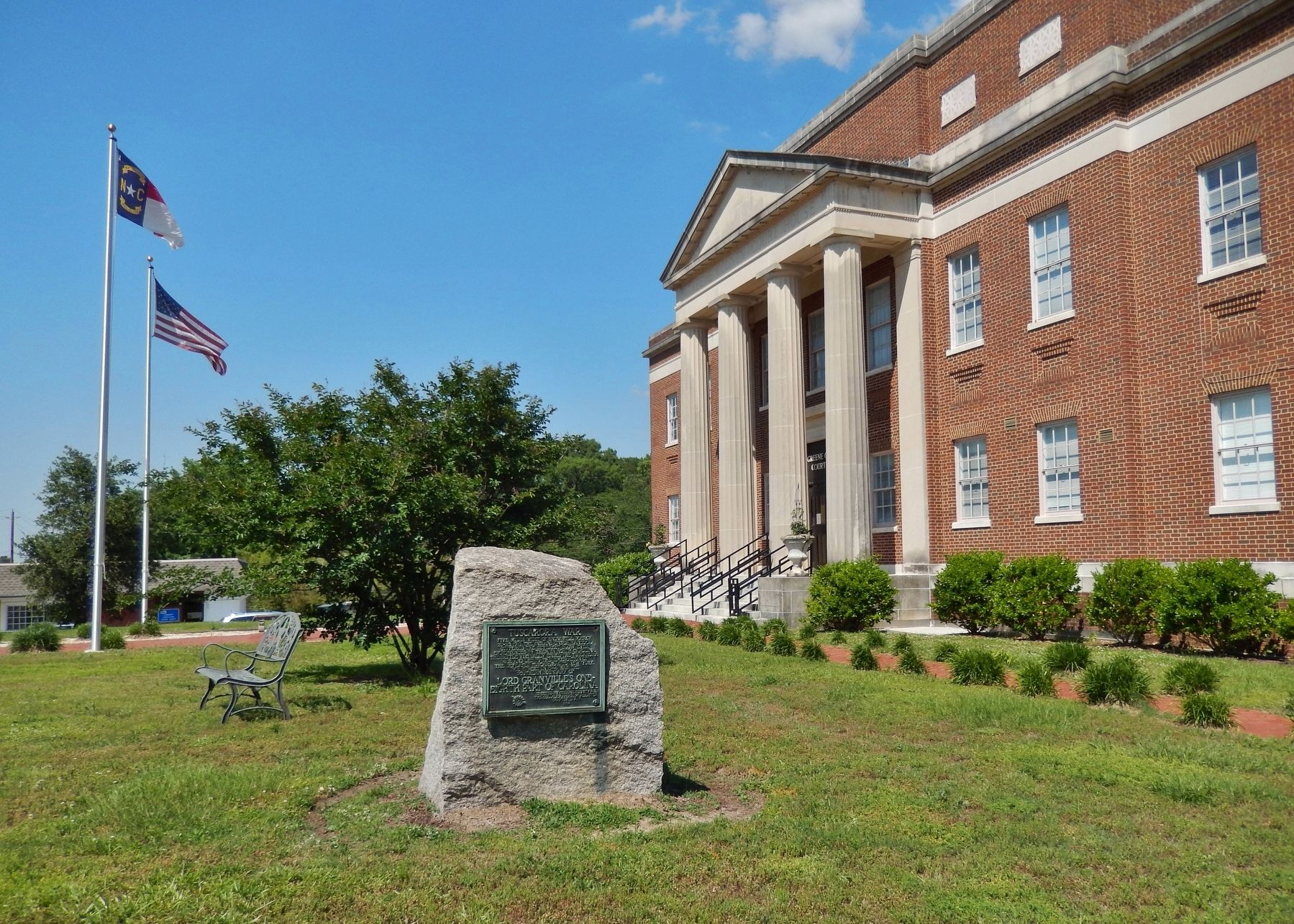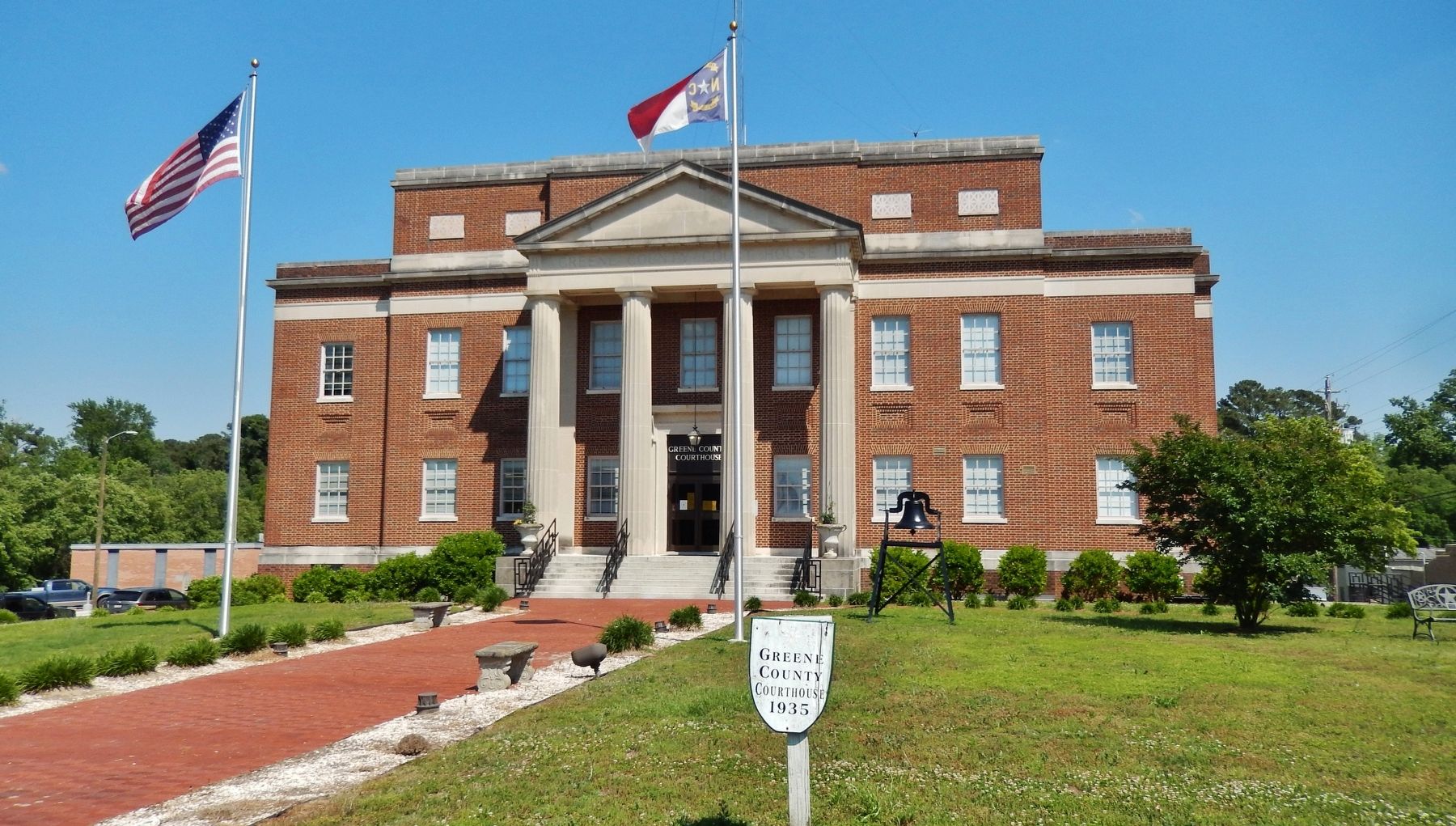Snow Hill in Greene County, North Carolina — The American South (South Atlantic)
Tuscarora War
Lord Granville's One-Eighth Part of Carolina
Five miles west of Snow Hill, March 20-23, 1713, the Indians under Hancock suffered the severest blow ever experienced by them in North Carolina. The battle virtually ended the Tuscarora War and led to the emigration of the defeated Tuscaroras to New York.
This street in 1744 was the southern boundary of Lord Granville's one-eighth part of Carolina.
Erected 1928 by Greene County and the Col. Alexander McAllister Chapter, D.A.R.
Topics and series. This historical marker is listed in these topic lists: Colonial Era • Native Americans • Wars, US Indian. In addition, it is included in the Daughters of the American Revolution series list. A significant historical date for this entry is March 20, 1713.
Location. 35° 27.322′ N, 77° 40.222′ W. Marker is in Snow Hill, North Carolina, in Greene County. Marker is at the intersection of SE 2nd Street (U.S. 258) and North Greene Street (U.S. 258), on the right when traveling west on SE 2nd Street. Marker is located near the southwest corner of the Greene County Courthouse. Touch for map. Marker is at or near this postal address: 301 N Greene St, Snow Hill NC 28580, United States of America. Touch for directions.
Other nearby markers. At least 8 other markers are within 11 miles of this marker, measured as the crow flies. Snow Hill (about 400 feet away, measured in a direct line); Grimsley Baptist Church (approx. 2˝ miles away); Hull Road (approx. 2˝ miles away); Nooherooka (approx. 3.6 miles away); James Glasgow (approx. 5 miles away); Wheat Swamp Church (approx. 7.7 miles away); Scuffleton Bridge (approx. 10.4 miles away); Farm Bell (approx. 10.8 miles away). Touch for a list and map of all markers in Snow Hill.
Also see . . .
1. Tuscarora War. North Carolina History Project website entry:
What is now Carteret, Pamlico, Craven, Lenoir, Jones, Beaufort, and Pitt Counties was a terrifying place to live from 1711 to 1713. North Carolinians and the Yamasee waged war against the Tuscarora. Many colonists’ settlements were burned and the Tuscarora ax indiscriminately fell upon men, women, and children. In the end, English colonists prevailed. Captured Tuscarora were sold into slavery and those that escaped northward joined the Iroquois League. (Submitted on February 27, 2018, by Cosmos Mariner of Cape Canaveral, Florida.)
2. Tuscarora War. Access Genealogy website entry:
The rapid encroachment of the whites on the lands of the Tuscarora and their Indian neighbors for a period of sixty years after the first settlements, although there was an air of peace and harmony between the two races, there were wrongs which dwarfed in comparison with the continued practice of kidnapping their young to be sold into slavery. This was the true cause of the so-called Tuscarora war in 1711-13. Years before the massacre of 1711, Tuscarora Indians were brought into Pennsylvania and sold as slaves. (Submitted on February 27, 2018, by Cosmos Mariner of Cape Canaveral, Florida.)
3. The Tuscarora War. 2016 book by David La Vere.
At dawn on September 22, 1711, more than 500 Tuscarora, Core, Neuse, Pamlico, Weetock, Machapunga, and Bear River Indian warriors swept down on the unsuspecting European settlers living along the Neuse and Pamlico Rivers of North Carolina. Over the following days, they destroyed hundreds of farms, killed at least 140 men, women, and children, and took about 40 captives. So began the Tuscarora War, North Carolina's bloodiest colonial war and surely one of its most brutal. In his gripping account, David La Vere examines the war through the lens of key players in the conflict, reveals the events that led to it, and traces its far-reaching consequences.(Submitted on March 12, 2022.)
La Vere details the innovative fortifications produced by the Tuscaroras, chronicles the colony's new practice of enslaving all captives and selling them out of country, and shows how both sides drew support from forces far outside the colony's borders. In these ways and others, La Vere concludes, this merciless war pointed a new direction in the development of the future state of North Carolina.
Credits. This page was last revised on March 14, 2024. It was originally submitted on February 27, 2018, by Cosmos Mariner of Cape Canaveral, Florida. This page has been viewed 800 times since then and 87 times this year. It was the Marker of the Week March 13, 2022. Photos: 1, 2, 3, 4. submitted on February 27, 2018, by Cosmos Mariner of Cape Canaveral, Florida. • Bernard Fisher was the editor who published this page.



